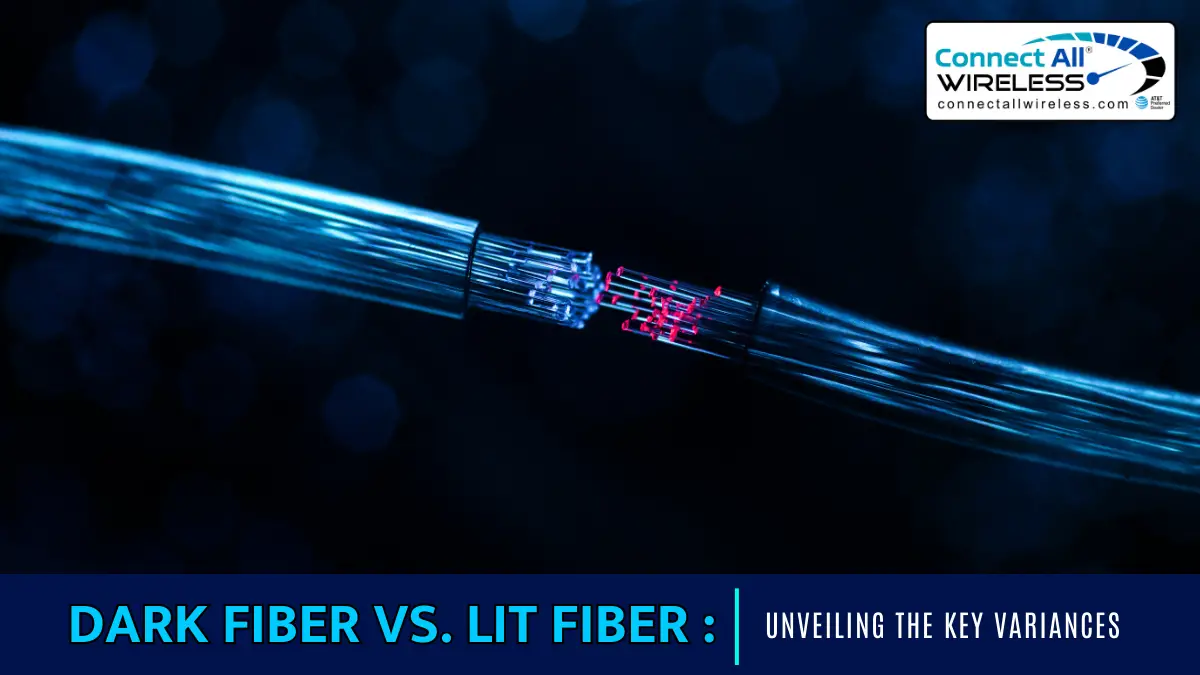Dark Fiber vs. Lit Fiber: Unveiling the Key Variances

In the realm of modern connectivity, the terms “dark fiber” and “lit fiber” frequently emerge in discussions surrounding network infrastructure. Both are crucial components in the world of telecommunications, yet they differ significantly in their functionality, cost implications, and potential applications. Understanding these distinctions is vital for businesses seeking optimal networking solutions. Let’s delve into the depths of dark fiber and lit fiber to illuminate their key variances.
The Foundation: What are Dark Fiber and Lit Fiber?
Dark Fiber:
Imagine a vast network of optical fibers laid beneath the ground or strung across utility poles. Now envision these fibers as “dark” — devoid of any data transmission. This is dark fiber: dormant, unutilized optical infrastructure that has the potential for data transmission but isn’t actively in use.
Lit Fiber:
On the contrary, lit fiber refers to optical fiber infrastructure that is actively transmitting data signals. Lit fiber networks are operational, with data being transmitted through these fibers via light signals. These networks are managed and maintained by service providers or telecommunications companies.
Unveiling the Variances:
1. Functionality:
-
Dark Fiber: It offers unparalleled flexibility. Companies leasing dark fiber gain complete control over the network's equipment and protocols. This level of control allows for customization, scalability, and the implementation of specific security measures tailored to their requirements.
-
Lit Fiber: Service providers manage lit fiber networks, offering convenience but limited control to end-users. While it's hassle-free, customization options are typically constrained.
2. Cost Implications:
-
Dark Fiber: Initially, the costs of leasing dark fiber might seem higher due to the need for additional equipment and maintenance. However, in the long run, it can lead to cost savings, especially for businesses with high data demands. Leasing dark fiber eliminates recurring service charges, offering potential savings as data needs grow.
-
Lit Fiber: Service charges, which encompass maintenance, data transmission, and network management, contribute to continuous operational expenses. While it might seem cost-effective in the short term, as data needs expand, these recurring costs could accumulate significantly.
3. Scalability and Bandwidth:
-
Dark Fiber: It provides unparalleled scalability. Businesses leasing dark fiber have the freedom to scale up their bandwidth as needed without major overhauls in infrastructure. This flexibility is ideal for industries with fluctuating data demands or those anticipating substantial growth.
-
Lit Fiber: Scalability is subject to service provider offerings. Expanding bandwidth often requires negotiations, potential service interruptions, and additional costs. Service providers might have limitations on bandwidth upgrades, constraining rapid scalability.
4. Security:
-
Dark Fiber: With complete control over the network, companies can implement customized security measures. This level of control offers a higher degree of security, crucial for sensitive data transmission.
-
Lit Fiber: Security measures are predominantly managed by the service provider. While they maintain certain security protocols, end-users have limited control over customization, potentially posing security concerns for highly sensitive data.
Potential Applications:
-
Dark Fiber: Ideal for large enterprises, data centers, research institutions, or industries requiring high bandwidth and stringent security measures. It’s beneficial for those aiming for complete control over their network infrastructure.
-
Lit Fiber: Suited for small to medium-sized businesses or those seeking hassle-free networking solutions without the complexities of managing and maintaining the network infrastructure.
Conclusion:
In the landscape of Fiber Internet in Michigan, the choice between dark and lit fiber hinges on diverse factors. Dark fiber offers unmatched control, scalability, and security customization, ideal for data-intensive enterprises or research facilities. Conversely, lit fiber provides convenience and managed services, suiting small to medium-sized businesses seeking hassle-free networking. Understanding these variances is critical for Michigan-based entities aiming to establish resilient, efficient network infrastructures. Whether it’s harnessing the power of complete autonomy or opting for managed services, the decision ultimately aligns with the specific demands, growth strategies, and security needs of Michigan businesses navigating the ever-evolving digital terrain.
- Art
- Causes
- Crafts
- Dance
- Drinks
- Film
- Fitness
- Food
- Games
- Gardening
- Health
- Home
- Literature
- Music
- Networking
- Other
- Party
- Religion
- Shopping
- Sports
- Theater
- Wellness
- Politics
- IT
- Relationship
- Blockchain
- NFT
- Crypto
- Fintech
- Automobile
- Faith
- Family
- Animals
- Travel
- Pets
- Coding
- Comedy
- Movie
- Game
- Computer


